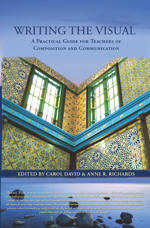|

David and Richards'
collection of essays, Writing the Visual, is practical in
nature, providing writing and communication instructors with
plenty of examples of classroom practices and assignments that
can teach students about visual rhetoric. In defining the
purpose and value of teaching visual rhetoric in relationship to
written texts, the editors claim that "Teachers of English who make the visual
a salient theme may find that students who recognize how an
image can persuade may be better able to articulate what
constitutes written persuasion or even argument; these students
likely will grasp, at the very least, that the distance between
visual and written cultures is less vast than they had imagined"
(p. 5). Thus, David and Richards' conclude that understanding
the relationship between visual and written texts, and the
subsequent usefulness of this knowledge, is essential and can be
handled by pedagogues when careful attention is given to visuals
in the context of a classroom.
The editors' first
chapter serves, then, as the introduction to the rest of the
essays in the text. In their introduction, David and
Richards offer short descriptions of several key points in the history of visual rhetoric.
Particularly, they point out the names and works of past
scholars who have had an impact on such scholarship, and they
use short examples that demonstrate why "digital and print media
are different and require distinct pedagogical approaches" (p. 4). Some of the threads
created by these descriptions include, among others, short
discussions about cultural studies, authenticity and
exploitation, and gender and women's studies.
The threads
highlighted by David and Richards are
meant to act as support for their claim that instructors should
do more to educate students about the visuals they encounter on
a daily basis. They do not provide an in depth examination
of the history of visual rhetoric, but rather give readers
suggestions for further research. Later in the text, these
threads are more fully developed by several of the essays'
authors.

|
